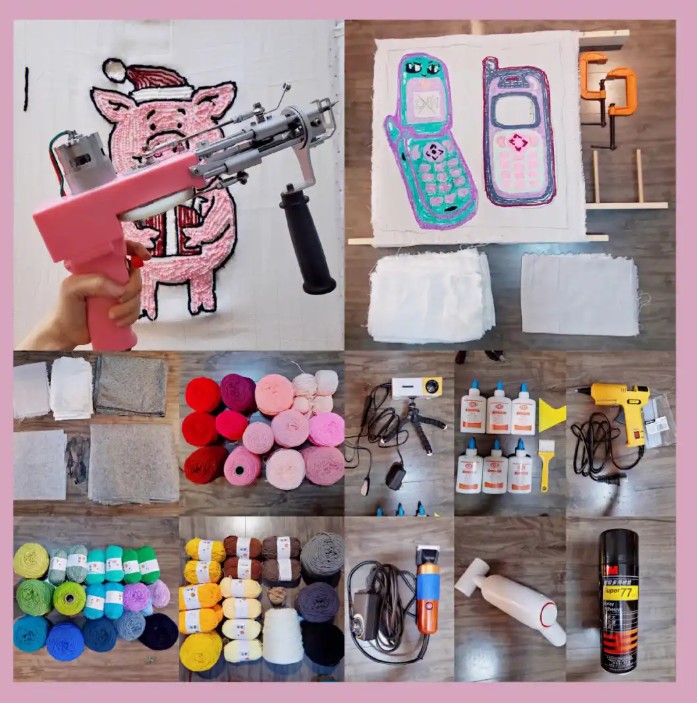I made a huge mistake when I first started tufting—I didn’t stretch my backing fabric properly! The result? My yarn didn’t stay in place, the fabric sagged, and I had to redo everything from scratch.
If you don’t want to face the same frustration, this guide will show you how to prepare your backing fabric the right way—so you can tuft with ease and create high-quality rugs from the start.

1️⃣ Choosing the Right Backing Fabric
Not all fabrics work well for tufting. If you choose the wrong one, you might end up with yarn slipping out, fabric tearing, or an unstable rug that falls apart over time.
Here’s a comparison of common backing fabrics to help you decide:
| Fabric Type | Material | Pros | Cons | Best For |
|---|---|---|---|---|
| Primary Tufting Cloth | Polyester + Cotton | Strong, pre-marked guidelines, easy to use | More expensive | Beginners & professionals |
| Monk’s Cloth | 100% Cotton | Flexible, widely available | Stretches over time, requires extra tensioning | Intermediate tufters |
| Burlap / Hessian | Rough fiber | Cheap, easy to find | Tears easily, not durable | Not recommended |
| Linen / Polyester Blend | Durable & low-stretch | High strength, professional use | More expensive | Advanced tufting & production |
👉 Best Choice for Most People: Primary Tufting Cloth – it’s durable, easy to work with, and prevents tufting mistakes.
2️⃣ How to Stretch Your Backing Fabric Properly
Even if you choose the right fabric, improper stretching can ruin your tufting experience. Here’s how to do it correctly:
✅ Step 1: Choose a sturdy tufting frame
- A wooden tufting frame is more stable than aluminum or makeshift frames.
- The frame should be large enough to hold your rug securely.
✅ Step 2: Attach the fabric using clamps or industrial staples
- Use strong clamps to fix all four corners.
- If using a staple gun, secure the fabric every 3-4 inches along the frame.
✅ Step 3: Check for proper tension
- Lightly press the center of the fabric—it should bounce back without sagging.
- If it moves too much, tighten it further.
✅ Step 4: Test before tufting
- Use a short piece of yarn to check if the fabric holds it firmly.
- If the fabric moves too much while tufting, it’s not tight enough.
💡 Pro Tip: If your fabric still feels loose, use additional clamps or strong elastic bands along the edges for extra stability.
3️⃣ Common Mistakes & How to Avoid Them
Many beginners make these common mistakes when setting up their fabric. Here’s how to avoid them:
❌ Mistake 1: Loose fabric → Solution: Always check tension before starting. If the fabric moves too much, re-stretch it.
❌ Mistake 2: Using the wrong fabric → Solution: Stick to Primary Tufting Cloth or Monk’s Cloth for the best results.
❌ Mistake 3: Yarn not sticking in the fabric → Solution: Ensure your fabric has the right weave density—too loose or too tight can cause issues.
By avoiding these mistakes, you’ll save time, reduce frustration, and create higher-quality rugs!
4️⃣ Final Tips for a Smooth Tufting Experience
✔️ Always stretch your fabric tightly before tufting to keep your yarn in place.
✔️ Use Primary Tufting Cloth for the best durability and ease of use.
✔️ Test your setup before tufting to prevent errors.
✔️ Check your frame stability—a weak frame can loosen the fabric.
Conclusion: Set Yourself Up for Success!
If you prepare your backing fabric properly, you’ll avoid frustration and enjoy a smooth tufting experience. A well-stretched fabric means your yarn stays in place, your design looks clean, and your rug lasts longer.
📌 Want to learn more? Check out the Tufting Mastery Class for expert tufting techniques!
Now that you know how to prepare your fabric correctly—you’re ready to start tufting like a pro! 🚀✨
